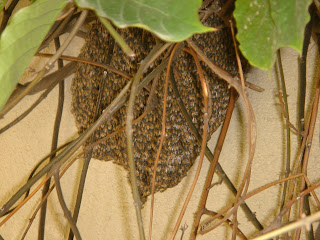
I found this honeycomb buzzing with bees, snug under the creeper on my wall-the flaming glory.
I wondered where the honey came from. Then I saw the bees collecting honey
from the Madhu Malti flowers every day morning.

Social bees use waxy secretions from their bodies to build large nests and
containers in which to store food and raise young.
About a year later I found the nest abandoned. Probably the bees were bumble bees and not honey bees as I had assumed. They produce honey too, but in lesser quantities compared to honey bees.

Where did the bees go? Not far but onto the silk cotton tree branch right outside our house.

In India, beekeeping has been mainly forest based. Several natural plant species provide nectar and pollen to honey bees. Thus, the raw material for production of honey is available free from nature.
Tribal populations and forest dwellers in several parts of India have honey collection from wild honey bee nests as their traditional profession. The methods of collection of honey and beeswax from these nests have changed only slightly over the millennia.
The major regions for production of this honey are the forests and farms along the sub-Himalayan tracts and adjacent foothills, tropical forest and cultivated vegetation in Rajasthan, Uttar Pradesh, Madhya Pradesh, Maharashtra and Eastern Ghats in Orissa and Andhra Pradesh.
Forest honey, mostly from rock bee hives, is usually collected by tribals in forests and is procured by forest or tribal corporations as a minor forest produce. Quite a large quantity is also collected by groups or individuals on their own.
Forest honey is usually thin, contains large quantity of pollen, bee juices and parts, wax and soil particles. The honey collector gets between Rs.10 and Rs.25 per kilogram of the forest honey.
Forest honeys are mostly multifloral. Wayanad district, which accounts for the bulk of wild honey in extracted from Kerala, yielded a total of 27,000 kg in 2006-07.
Wild honey is mostly purchased by ayurvedic drug makers, whose demand for natural, unadulterated honey has been on the rise.






